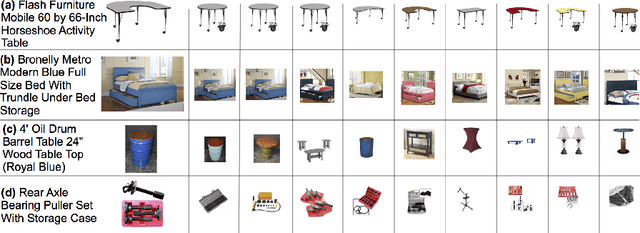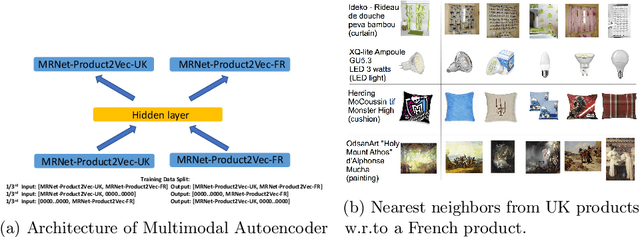Subhajit Sanyal
Multi-Objective Optimization via Wasserstein-Fisher-Rao Gradient Flow
Nov 22, 2023



Abstract:Multi-objective optimization (MOO) aims to optimize multiple, possibly conflicting objectives with widespread applications. We introduce a novel interacting particle method for MOO inspired by molecular dynamics simulations. Our approach combines overdamped Langevin and birth-death dynamics, incorporating a "dominance potential" to steer particles toward global Pareto optimality. In contrast to previous methods, our method is able to relocate dominated particles, making it particularly adept at managing Pareto fronts of complicated geometries. Our method is also theoretically grounded as a Wasserstein-Fisher-Rao gradient flow with convergence guarantees. Extensive experiments confirm that our approach outperforms state-of-the-art methods on challenging synthetic and real-world datasets.
Think out of the package: Recommending package types for e-commerce shipments
Jun 05, 2020



Abstract:Multiple product attributes like dimensions, weight, fragility, liquid content etc. determine the package type used by e-commerce companies to ship products. Sub-optimal package types lead to damaged shipments, incurring huge damage related costs and adversely impacting the company's reputation for safe delivery. Items can be shipped in more protective packages to reduce damage costs, however this increases the shipment costs due to expensive packaging and higher transportation costs. In this work, we propose a multi-stage approach that trades-off between shipment and damage costs for each product, and accurately assigns the optimal package type using a scalable, computationally efficient linear time algorithm. A simple binary search algorithm is presented to find the hyper-parameter that balances between the shipment and damage costs. Our approach when applied to choosing package type for Amazon shipments, leads to significant cost savings of tens of millions of dollars in emerging marketplaces, by decreasing both the overall shipment cost and the number of in-transit damages. Our algorithm is live and deployed in the production system where, package types for more than 130,000 products have been modified based on the model's recommendation, realizing a reduction in damage rate of 24%.
eCommerceGAN : A Generative Adversarial Network for E-commerce
Jan 10, 2018



Abstract:E-commerce companies such as Amazon, Alibaba and Flipkart process billions of orders every year. However, these orders represent only a small fraction of all plausible orders. Exploring the space of all plausible orders could help us better understand the relationships between the various entities in an e-commerce ecosystem, namely the customers and the products they purchase. In this paper, we propose a Generative Adversarial Network (GAN) for orders made in e-commerce websites. Once trained, the generator in the GAN could generate any number of plausible orders. Our contributions include: (a) creating a dense and low-dimensional representation of e-commerce orders, (b) train an ecommerceGAN (ecGAN) with real orders to show the feasibility of the proposed paradigm, and (c) train an ecommerce-conditional-GAN (ec^2GAN) to generate the plausible orders involving a particular product. We propose several qualitative methods to evaluate ecGAN and demonstrate its effectiveness. The ec^2GAN is used for various kinds of characterization of possible orders involving a product that has just been introduced into the e-commerce system. The proposed approach ec^2GAN performs significantly better than the baseline in most of the scenarios.
MRNet-Product2Vec: A Multi-task Recurrent Neural Network for Product Embeddings
Sep 21, 2017



Abstract:E-commerce websites such as Amazon, Alibaba, Flipkart, and Walmart sell billions of products. Machine learning (ML) algorithms involving products are often used to improve the customer experience and increase revenue, e.g., product similarity, recommendation, and price estimation. The products are required to be represented as features before training an ML algorithm. In this paper, we propose an approach called MRNet-Product2Vec for creating generic embeddings of products within an e-commerce ecosystem. We learn a dense and low-dimensional embedding where a diverse set of signals related to a product are explicitly injected into its representation. We train a Discriminative Multi-task Bidirectional Recurrent Neural Network (RNN), where the input is a product title fed through a Bidirectional RNN and at the output, product labels corresponding to fifteen different tasks are predicted. The task set includes several intrinsic characteristics about a product such as price, weight, size, color, popularity, and material. We evaluate the proposed embedding quantitatively and qualitatively. We demonstrate that they are almost as good as sparse and extremely high-dimensional TF-IDF representation in spite of having less than 3% of the TF-IDF dimension. We also use a multimodal autoencoder for comparing products from different language-regions and show preliminary yet promising qualitative results.
 Add to Chrome
Add to Chrome Add to Firefox
Add to Firefox Add to Edge
Add to Edge